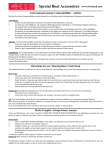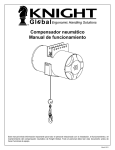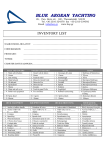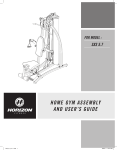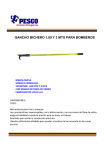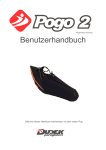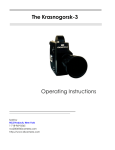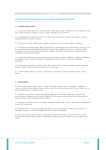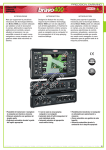Download Special Boat Accessoires www.swi-tec.it - SWI
Transcript
Special Boat Accessoires www.swi-tec.it Gebrauchsanweisung: Leineneinfädler - Aufsatz Mit dem SwissTech Leineneinfädler-Aufsatz können Sie ein beliebig starkes Belegtau durch Bojenringe hindurchziehen. Anwendung 1. Aufsatz auf den Bootshaken aufstecken und mittels Feststellschraube (1) fixieren. 2. Am Ende der roten Hilfsleine, die am kleinen Befestigungsring (2) befestigt ist, ein beliebiges Belegtau festknoten. Das andere Ende vom Belegtau anschliessend an Bord belegen. 3. An die Boje heranfahren und mit dem Aufsatz von der rechten Seite am Bojenauge (siehe Foto unten) einhängen. Bootshaken im Gegenuhrzeigersinn verdrehen bis der Bügel des Aufsatzes auf der Gegenseite (3) im Bügel einrastet. In diesem Moment löst sich die Verriegelung (4). Die Hilfsleine ist dadurch bereits durch den Ring hindurchgeführt. 4. Bootshaken mit dem Aufsatz wieder an Bord ziehen und an der roten Leine das Belegtau durch den Ring an Bord zurückholen und Schiff belegen. Achtung: Um den Leineneinfädler wieder für den nächsten Einsatz vorzubereiten, wird wie folgt vorgegangen: 1. Zuerst das Auge (6) beim Bügel (3) bei der Feder (5) einhängen. 2. Anschliessend kann die Gegenseite mit dem Bajonettverschluss (4) eingesteckt und verdreht werden. Somit ist der Leineneinfädler wieder geöffnet und für den nächsten Einsatz bereit. Empfehlung: Der Leineneinfädler ist nicht für Manöver bei Starkwind konzipiert, dafür empfiehlt sich der Bojen-Bergeaufsatz zum Anlegen besser. Nach dem provisorischen Festmachen eignet sich der Einfädler perfekt um komfortabel den eigenen Festmacher auf Distanz durch den Ring zu ziehen. Für den Einsatz unseres Leineneinfädlers benötigen Sie entweder unseren speziellen Bootshaken, den Adapter oder die separate Bootshakenspitze. Directions for use: Mooring Buoy Catch Hook The patented Mooring Catch Hook is a device to facilitate the safe threading of any sized line through any buoy or mooring ring. How to use: 1. Attach the Mooring Catch Hook to your boat hook by securing it with the black knob. (1) 2. Attach your rope to the small red line of the Catch Hook. 3. Hook the buoy or mooring ring from the right site (see foto below) and turn the boat hook anti-clockwise until the ring of the arm is located in the hook (3) thereby opening the lock of the Catch Hook (4) and releasing the arm. The red line is now threaded through the buoy ring. 4. Pull the boat hook on board and fasten down the line. Important: Resetting the mechanism: To reset the Mooring Catch Hook for the next use you must do the following: 1. Attach the eye (6) to the hook (3) 2. relocate the other end into the bayonette (4), turning it clockwise until it is completly open. Tip: The Mooring Buoy Catch Hook is not intended for rough sea. In these conditions we recommend using the Mooring Buoy Retrieving Hook. To establish a temporary mooring and then you can use the Mooring Buoy Catch Hook safely and easily to pass rope round the buoy from distance. To be used inconjunction with a SwissTech telescopic boat hook, adaptor or boat hook tip. Mode d’emploi: Attrape-bouée, anneau Toutes nos félicitations, vous venez d’acquérir le CROCHET ATTRAPE-BOUEE SWISSTECH, un magnifique accessoire qui vous permet de passer, à distance, une ligne à travers n’importe quel anneau de bouée et de la ramener à bord. Instructions: 1. Fixez le CROCHET PASSE-AMARRE à votre gaffe en le bloquant au moyen du bouton noir (1) 2. Joignez votre amarre à la cordelette rouge (2). 3. Attrapez l’anneau avec le crochet à droit de la bouée (regarder la photo en bas), faites pivoter la gaffe dans le sens contraire des aiguilles d’une montre jusqu’à ce que l’anneau du bras (3) passe dans le crochet (4). Simultanément le mécanisme du crochet s’ouvre et libère le bras. La cordelette rouge passe maintenant à travers l’anneau de la bouée. 4. Ramenez la gaffe à bord, récupérez l’amarre et tournez-la sur un taquet. Important Pour réarmer le mécanisme procédez comme suit: Premièrement, attachez l’œil (6) au crochet (3), puis introduisez l’autre extrémité (5) dans la baïonnette en tournant dans le sens des aiguilles d’une montre jusqu’à ce que le crochet soit complètement ouvert. Special Boat Accessoires www.swi-tec.it Conseil: Ce passe-ligne n’a pas été conçu pour manoeuvrer par fort vent. Dans ce cas il vaut mieux utiliser la gaffe attrape-bouée. Après vous être provisoirement amarré, vous pouvez utiliser facilement le passe-ligne pour passer votre amarre définitive à distance. Pour cette opération vous avez besoin de notre gaffe téléscopique avec l’adaptateur ou l’embout de gaffe SwissTech. Manuale d’uso: Passacime per boa d'ormeggio Il passacime con ns. attacco brevettato è l'accessorio ideale per infilare la propria cima nell’anello del gavitello. Modo d’uso 1) Attaccateil retro del passacimeal nostromezzomarinaioassicurandoloconilbottonenero(2) 2) Attaccate la vs. cima d'ormeggio alla cimetta rossa sottile del passacime per boa 3) Prendete l’anello della boa con il passacime e girate il mezzomarinaio a 90° finché l’occhiello del braccio (4) non siaposizionatonelgancio(3),aprendoinquestomodolachiusuradelpassacima(8),liberandoilbraccio. La cimarossa risulta infilata nell’occhiello della boa. 4) Tirate il mezzo marinaio a bordo e fissate la cima Importante : Risistemazione del meccanismo : Perprepararepassacimeperl’usosuccessivobisognafareiseguentimovimenti: Primaattaccateil gancio(4)all’attacco(3),poiriposizionatel’altraparte(8)dentrol'attacco,girandolainsensoorariofinchési apre completamente. Raccomandazione: Questo passacime per boa ormeggio non è previsto per il vento forte. Dopo aver ormeggiato provvisoriamente il passacime si adopera a distanza per far passare la propria cima di ormeggio a doppino attraverso l’anello. Importante:In manovra vi servirà il nostro mezzomarinaio speciale, l’innesto separato o il puntale del mezzomarinaio. El modo de empleo: Gancho pasacabos Con el gancho pasacabos de SwissTech puede pasar un cabo a travès de cualquier boya. El uso 1. Atar el gancho en el bichero con el tornillo (1) y apretar 2. Al final del cabo rojo que esta atado en el pequeño anillo (2) hay que atar su cabo de amarre. El fin del amarre puede atar de primero en la cornamusa. 3. Enganchar con el gancho en la boya. Gira el bichero contra reloj hasta que se cierre el gancho en frente. En este momento se abre la otra parte del gancho y el cabo pasa el anillo de la boya. 4. Tirar el cabo rojo con el amarre y atar en el barco. Atención Para preparar el gancho pasacabos para la proxima véz hay que hacer lo siguiente: 1. Enganchar la parte suelta en el ojo (6) con el muelle (5) 2. Despues enganchar en la parte con el „bajonet“ y girar para abrir el gancho Ahora el gancho esta otra véz preparado. Consejo:Este gancho no está construido para usar con viento duro, es mejor usar el gancho para amarrar boyas. Despues del amarre provisional el gancho pasacabos puede servir para pasar su propio cabo de amarre en el aro de la boya. El uso de nuestro gancho pasacabos hace necesario el empleo, bien sea de nuestro bichero, del adaptador o de la punta del bichero separada! 2 4 1 5 3 6


